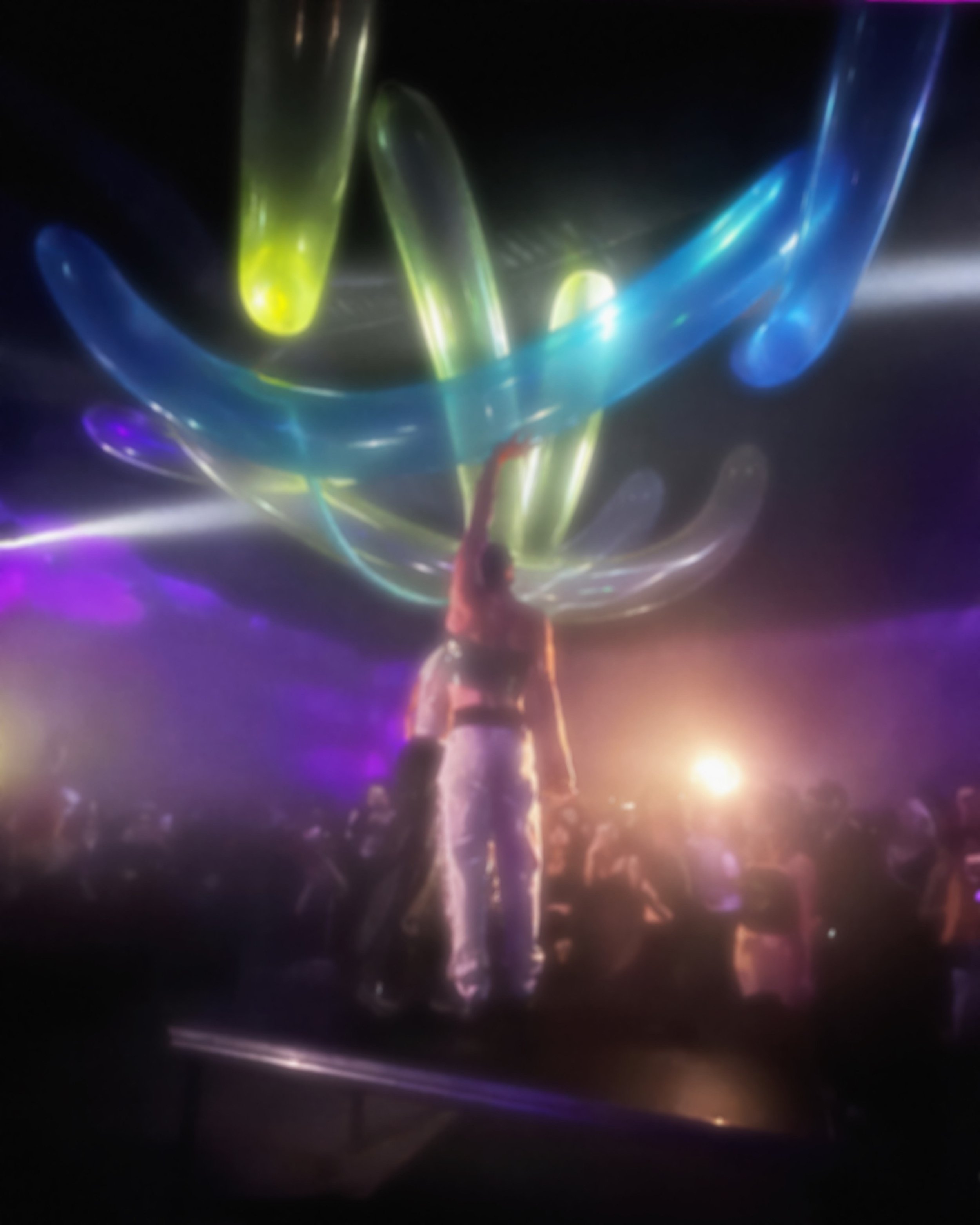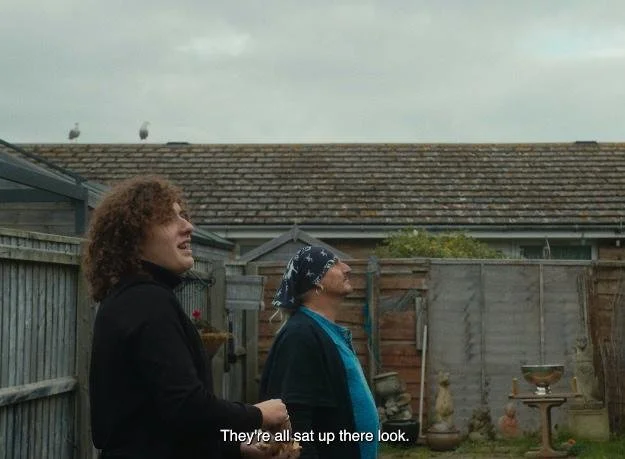CLUB ARE
Organiser and curator Mika Kailes explains his vision in tying together elements of art exhibition, performance and rave for London’s new queer club night: Club Are.
As numbers of queer venues in London are dwindling, it is a relief to see a new club night introduce itself on the scene, especially when it’s one as exciting and fresh as Club Are (@club_are). Club Are made its debut on November 11th 2023, inviting its audience to a twelve-hour immersive experience of music, visual art, and performance. Figurehead DJs of the London queer scene such as Tedesco and Marceldune led the clubgoers on a journey through progressive and uplifting electronic sounds, while a large scale installation of giant balloons by artist Frederick Tjærandsen hovered overhead, creating a surreal atmosphere with the crowd dancing to thumping techno below. In the early evening, a hushed anticipation was palpable for a performance by artists Lewis Walker, Josh Woolford, Lulu Wang and Anna-Lena Krause, created in relation to the work by Tjærandsen. Their choreography weaved through the crowd, the audience almost becoming participants to the work as the boundaries between stage and floor blurred. After, the music resumed, leading the crowd into the joyous final hours of the night.
With the next edition just around the corner on January 27th, meet Mika Kailes (@mikakailes), organiser and curator of Club Are to talk about the mission and future of the club night.
Hi Mika! Can you tell us how the initial idea for Club Are came about, and how it developed from the concept into the event?
The idea of organising events which would cross-over of all the art forms I enjoy has been with me for quite a while now! Already before the pandemic, during my studies at Central Saint Martins in Fashion Communication and Promotion, I remember having conversations with friends about the vision for an experimental club night that would include visual art and performance. It would be something where each edition is curated with a specific vision, an event that could platform emerging artists and serve as a safe and inclusive space.
While the idea kept growing and shaping over the years, I worked on other events in photography and fine arts, which gave me the confidence and experience to push forward. I met some people who were all enthusiastic about the concept of Club Are, and when the opportunity presented itself to organise an event on this scale, we formed a small team to make it happen. We take on different parts of the work: I focus mainly on the curatorial aspect of the event, Abdula Jama works on the more logistical side, and resident DJ Eoin Ryan has taken on the sound. It’s still very fresh and there’s a lot of space for experimentation, which is very exciting!
Where does the name Club Are come from? Does it have a specific origin, and what does it say about the event?
The name is actually a reference to a track by U96 from the 90’s called Club Bizarre. I love the sounds from the late 90s and early 200s, and this album was on repeat for me during the pandemic. I think it’s such a legendary and energetic track and it perfectly represents what I want the energy of Club Are to be, also on a visual level. I wanted to find a name that feels familiar but doesn’t quite have a meaning, so people can attach their own associations to it.
There’s a long tradition of queer nightlife incorporating elements of visual art and performance. What is your vision with Club Are, what makes it special?
That’s true! With Club Are, I want to take the combination of art and clubs somewhere else, somewhere where all artforms come together in an integrated, curated programme. It is important for me to break down the hierarchy between different disciplines, inviting artists that are not necessarily from the club scene, but rather from the contemporary artworld to participate. Each edition has its own overarching concept to link the different artistic fields together, but also to keep every event varied and experimental.
How do you approach the curation of each concept?
I start from a general theme that I want to explore, and from there I select a number of artists and DJs that I feel connect to the concept. From there, the process is very collaborative – we work together on developing the type of work that is exhibited or staged, from the initial discussions to the final production. As a visual artist myself, I think my way of working is quite artist led, with a lot of creative freedom for the artists to interpret the concept and bring their own take on it.
On the musical side, I brief the DJs on the energy of Club Are and the general sonic vibe. I want to explore more uplifting music, and venture into genres like tech-house and late 90s hard house – not necessarily the dark or dystopic side. It’s still developing, but I’m looking forward to Club Are having its own distinctive sound.
By carefully curating each edition and working in this collaborative way, my intention is for the resulting event to feel cohesive, daring and slick: a real celebration of creativity. It’s a place where the audience can experience some amazing art and music, a place that prioritises self-expression in a safe, diverse and inclusive environment.
Can you tell me about more about the artists that you are working with?
The goal is to provide a platform for emerging artists and DJs, new voices, people that I think are exciting and that are doing something interesting. Seeing that every edition will have its distinct theme, there’s so many possibilities in who to work with! As it’s not a typical gallery or club setting, there’s a lot of room for everyone to experiment, to take risks and develop their practice further. We want to foster collaboration between artists and support interdisciplinary projects: it was so amazing to see how the performance for the first edition, with Anna-Lena Krause, developed to be what it was by having her collaborators bring something of their own to the work. Most of the DJ’s I know from the London queer club scene, and they felt right for the concept last time. Frederick Tjærandsen I’ve actually known for a long time, we have worked together before and we’ve even discussed the idea for Club Are before it became what it is. It only made sense for him to create the inflatable installation, which really looked amazing in the space.
Thank you so much for taking the time to talk! Lastly, is there something you can maybe share about the upcoming editions of Club Are?
We’re exploring themes of astrobiology and solar activity next time, on the 27th of January 2024. There will be an audiovisual work by Arna Beth, and a performance piece by Zahra Van Nguyen, alongside sets from DJs like MDSM, LO-LOW and Wednesday. Going forward, I want to document the editions almost as exhibitions, providing install shots and images of events as a record for the artists. I have so many more ideas for the future, people I want to collaborate with, music genres to explore, working with other curators…it’s just the beginning!
CLUB ARE
MIKA KAILES
Interview ANNA BONSINK
What to read next




















